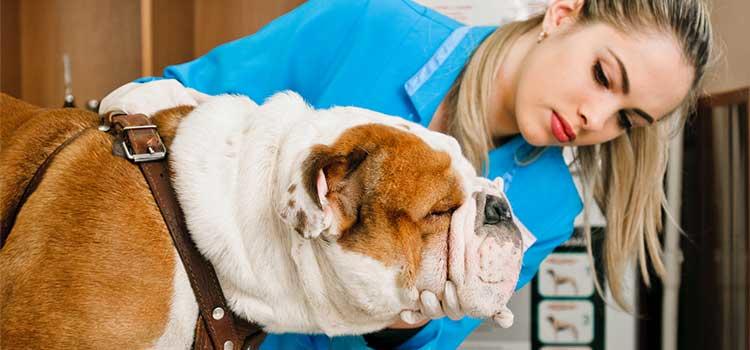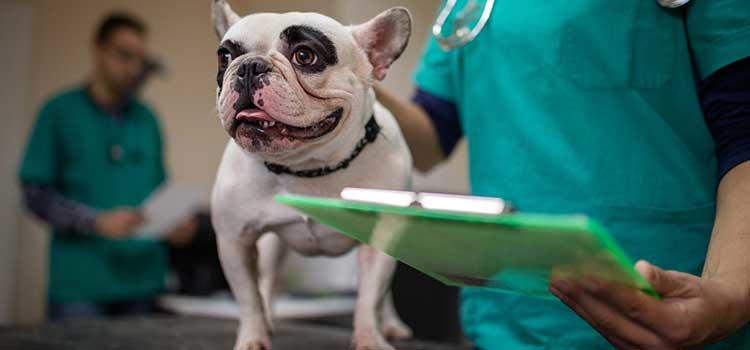Feb. 12, 2017
The issue with flat-faced dogs
As she contemplates the debate about short-muzzled or flat-faced dogs, such as pugs or bulldogs, and the health problems that can affect them, veterinarian Aylin Atilla looks at her own pet.
Digby is a 13-year-old chocolate Labrador who suffers from laryngeal paralysis, a condition that can affect certain larger, non-short-muzzled dogs as they age, she says. Certain nerves controlling muscles that allow the larynx to open and close normally when breathing and swallowing stop functioning, restricting the larynx’s ability to do such tasks, as well as causing overheating.
"Certain breeds are predisposed to certain issues, so you need to educate yourself."
“I think it’s part of owning a living being,” says Dr. Atilla, an assistant professor in the Faculty of Veterinary Medicine at the University of Calgary. “It’s like Dachshunds can have back problems. Certain breeds are predisposed to certain issues, so you need to educate yourself.”
Veterinary association issues warning
The British Veterinary Association warned in 2016 that everyone from breeders and veterinarians to pet owners should start considering the health problems perpetuated by breeding and buying dogs that are brachycephalic, a scientific term meaning “short head.” These include everything from Shih Tzus and pugs to boxers, Boston terriers and Pekinese, as well as French and English bulldogs.

.
They basically have a squished face compared to other dogs, potentially creating side effects that can range from protruding eyes to extra folds of facial skin that can lead to chronic skin infections. They can also have difficulties with breathing and overheating that place them at a greater risk than other dogs of dying during air travel, causing several airlines to put restrictions on them.
“Their muzzle is much shorter than other dogs and this has brought about a constellation of problems,” says Atilla. It can cause parts of their upper airway to be undersized or flattened, including stenotic nares or pinched nostrils, she says.
Such dogs can also have tighter nasal turbinates, which are scrolls of bone covered in pink tissue or mucosa similar to that of the lining of the mouth, she says. Their normal function is to filter and warm the air before it reaches the lungs, but when they are tighter or malformed, they can make breathing harder for brachycephalic dogs.
Other conditions can include an elongated soft palate at the back of the roof of the mouth, which can cause excess tissue to dangle into the airway, Atilla says. “It’s what makes that kind of snoring sound that you can hear from them if you walk by a French bulldog or a pug.”
Brachycephalic dogs can also have hypoplastic tracheas, which means their tracheas are smaller in diameter than other dogs of the same size. Atilla says one way to think about it is that they have a smaller straw to breathe through, making it harder to convey air to the lungs.
The extra effort it can take to overcome all these obstacles to breathe — which has been likened to having a permanent cold while having a clothespin on your nose — can lead to everted laryngeal saccules, or tissue in front of the vocal chords getting pulled into the trachea, she says.
Symptoms caused by these conditions, which can be aggravated by being overweight, can include gagging due to difficulty swallowing, and sterterous or noisy respiration when breathing inward. It can even include cyanosis, or blue gums and tongues from lack of oxygen, and difficulty sleeping. Breathing is also the main way dogs get rid of excess heat, placing brachycephalic breeds at greater risk of overheating and going into respiratory distress during exercise or hot weather.
“Over time, if you don’t address any of these issues and try to improve their airflow, it can cause chronic cartilage pressure and so their larynxes can actually collapse,” says Atilla. “You can’t really undo that damage and it’s almost a death sentence for dogs. Veterinarians have a few tricks we can try, but the chances of us being successful are minimal.”
Due to such problems, the British Veterinary Association said prospective owners should instead choose a “healthier alternative breed, or crossbreed,” adding that local veterinary practices were “ideally placed to give this advice.”

.
Gaining in popularity
While exact numbers aren’t available, the Canadian Animal Health Institute estimated there were 6.4 million pet dogs in Canada in 2014. The Canadian Kennel Club said the top 10 most popular breeds in 2015 included brachicephalic dogs such as French bulldogs – a breed that rose to ninth place that year, up from 67th place in 2005.
As part of the department of veterinary clinical and diagnostic services at the Faculty of Veterinary Medicine, Atilla’s duties include performing corrective surgery on brachycephalic dogs. She understands why a seemingly growing number of people like them.
"They’re just friendly and they can be wonderful family pets, so I can totally understand why people get them."
“I think they’re really cute,” she says. “French bulldogs can be like a large dog in a little body. They’re just friendly and they can be wonderful family pets, so I can totally understand why people get them. But they certainly have a lot of issues that require veterinarians, and that’s something to be well informed about before you get one.”
Corrective surgery recommended
She recommends that surgery be conducted on brachycephalic dogs by the time they’re two years old. “Whenever we can, we try to remove some of the excess tissue that’s in the way and allow them to breathe just a little bit easier,” says Atilla. “A lot of the time, it consists of shortening their soft palates and also opening up their nasal passages, even if it’s just opening up the nostrils.”
If such surgery is done on an elective basis, the cost can be between $2,200 and $3,000, she says. “If you wait until your dog runs into trouble, it becomes an emergency and they may potentially have to be on oxygen for a while, so the cost can go up significantly.”
Dogs were the first animals to be domesticated by humans, a complicated process which likely began tens of thousands of years ago. While the exact interplay between dog evolution and people is currently being debated by scientists, artificial selection for a variety of traits desired by different societies played a role in the creation of modern breeds as far apart as St. Bernards and pugs.

.
Dogs in all their many forms wouldn’t exist without people, complicating the debate about dog breeding and health, says Atilla. “It becomes a whole philosophical issue and I think it’s a hard one to answer,” she says.
“There are many other characteristics that people looked at for brachycephalic dogs, including whether they are friendly and make good family dogs. You can’t tell a person that has a genetic issue that they shouldn’t have kids, and that’s a whole ball of wax that we don’t get into because it’s not up to us.”
Researchers and veterinarians need to work with dog breeders to create breed standards that are balanced, says Atilla, adding that things such as dog shows tend to emphasize fashionable esthetic considerations when picking winners, perpetuating potential health problems because champion dogs have more offspring.
“I certainly think that we need to do research and educate people,” she says. “We need to find out what the causes are for certain of these issues, and if we can avoid them, we should try to further the science that way.”
This is something that would be voluntary, says Atilla, adding she doesn’t see any means of enforcing restrictions on dog breeders. “Unfortunately, I don’t think it’s realistic for someone to say, ‘You know what, you shouldn’t breed French bulldogs anymore because they have shmushed faces.’”
Explore our Veterinary Medicine program
– – – – –
ABOUT OUR EXPERTS
Dr. Aylin Atilla, DVM, is an assistant professor in the Faculty of Veterinary Medicine at the University of Calgary. She is a board certified small animal surgeon (Diplomate American College of Veterinary Surgeons – acvs.org) and spent 6 years in private practice before following her passion and starting to teach at the University of Calgary in late 2013. She is currently engaged in research looking at simulators to enhance student teaching as well as looking at intraosseus catheters and fluid delivery to dogs and the most appropriate way to close tissue layers in cats. She has a special interest in soft tissue surgery (including airway surgery, surgery for reconstruction of wounds and to remove tumors) as well as neurosurgery.

